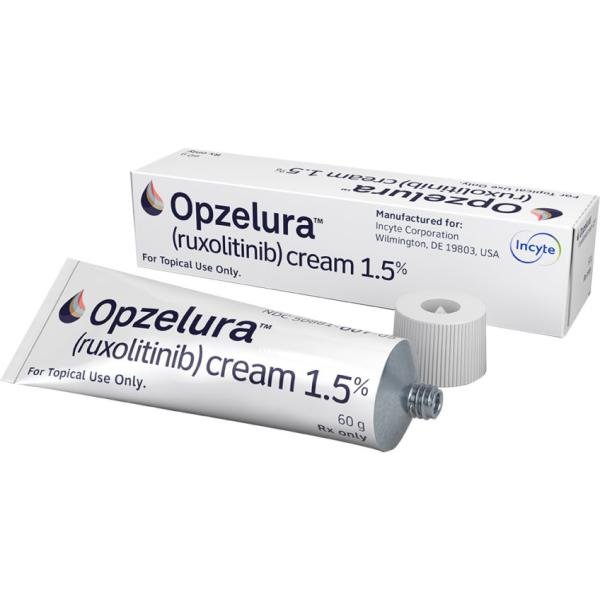Ruxolitinib Topical Dosage
Medically reviewed by Drugs.com. Last updated on Mar 26, 2025.
Applies to the following strengths: 1.5%
Usual Adult Dose for:
Usual Pediatric Dose for:
Additional dosage information:
Usual Adult Dose for Atopic Dermatitis
Atopic Dermatitis
Maintenance dose: Apply 2 times daily to affected areas of up to 20% of body surface area.
Comments:
- Do not use more than one 60 gram tube per week or one 100 gram tube per 2 weeks.
- Stop using when signs and symptoms (itch, rash, redness) of atopic dermatitis resolve.
- Re-examine patient if there is no improvement within 8 weeks.
Use: For the topical treatment of short-term and non-continuous chronic mild to moderate atopic dermatitis in non-immunocompromised patients whose disease is not adequately controlled with topical prescription therapies or when those therapies are not advisable
Nonsegmental Vitiligo
Maintenance dose: Apply 2 times daily to affected areas of up to 10% of body surface area.
Comments:
- Do not use more than one 60 gram tube per week or one 100 gram tube per 2 weeks.
- Adequate response may be achieved with treatment for more than 24 weeks.
- Re-examine patient if there is no meaningful repigmentation by 24 weeks.
Use: For the topical treatment of nonsegmental vitiligo
Usual Adult Dose for Vitiligo
Atopic Dermatitis
Maintenance dose: Apply 2 times daily to affected areas of up to 20% of body surface area.
Comments:
- Do not use more than one 60 gram tube per week or one 100 gram tube per 2 weeks.
- Stop using when signs and symptoms (itch, rash, redness) of atopic dermatitis resolve.
- Re-examine patient if there is no improvement within 8 weeks.
Use: For the topical treatment of short-term and non-continuous chronic mild to moderate atopic dermatitis in non-immunocompromised patients whose disease is not adequately controlled with topical prescription therapies or when those therapies are not advisable
Nonsegmental Vitiligo
Maintenance dose: Apply 2 times daily to affected areas of up to 10% of body surface area.
Comments:
- Do not use more than one 60 gram tube per week or one 100 gram tube per 2 weeks.
- Adequate response may be achieved with treatment for more than 24 weeks.
- Re-examine patient if there is no meaningful repigmentation by 24 weeks.
Use: For the topical treatment of nonsegmental vitiligo
Usual Pediatric Dose for Atopic Dermatitis
12 years and older:
Atopic Dermatitis
Maintenance dose: Apply 2 times daily to affected areas of up to 20% of body surface area.
Comments:
- Do not use more than one 60 gram tube per week or one 100 gram tube per 2 weeks.
- Stop using when signs and symptoms (itch, rash, redness) of atopic dermatitis resolve.
- Re-examine patient if there is no improvement within 8 weeks.
Use: For the topical treatment of short-term and non-continuous chronic mild to moderate atopic dermatitis in non-immunocompromised patients whose disease is not adequately controlled with topical prescription therapies or when those therapies are not advisable
Nonsegmental Vitiligo
Maintenance dose: Apply 2 times daily to affected areas of up to 10% of body surface area.
Comments:
- Do not use more than one 60 gram tube per week or one 100 gram tube per 2 weeks.
- Adequate response may be achieved with treatment for more than 24 weeks.
- Re-examine patient if there is no meaningful repigmentation by 24 weeks.
Use: For the topical treatment of nonsegmental vitiligo
Usual Pediatric Dose for Vitiligo
12 years and older:
Atopic Dermatitis
Maintenance dose: Apply 2 times daily to affected areas of up to 20% of body surface area.
Comments:
- Do not use more than one 60 gram tube per week or one 100 gram tube per 2 weeks.
- Stop using when signs and symptoms (itch, rash, redness) of atopic dermatitis resolve.
- Re-examine patient if there is no improvement within 8 weeks.
Use: For the topical treatment of short-term and non-continuous chronic mild to moderate atopic dermatitis in non-immunocompromised patients whose disease is not adequately controlled with topical prescription therapies or when those therapies are not advisable
Nonsegmental Vitiligo
Maintenance dose: Apply 2 times daily to affected areas of up to 10% of body surface area.
Comments:
- Do not use more than one 60 gram tube per week or one 100 gram tube per 2 weeks.
- Adequate response may be achieved with treatment for more than 24 weeks.
- Re-examine patient if there is no meaningful repigmentation by 24 weeks.
Use: For the topical treatment of nonsegmental vitiligo
Renal Dose Adjustments
Data not available
Liver Dose Adjustments
Data not available
Precautions
US BOXED WARNINGS:
Serious Infections:
- Patients treated with oral JAK inhibitors are at risk of developing serious infections that may lead to hospitalization or death. Reported infections include:
- Active tuberculosis (TB), with possible pulmonary or extrapulmonary disease
- Invasive fungal infections, including cryptococcosis, and pneumocystosis
- Bacterial, viral (i.e. herpes zoster), and other infections caused by opportunistic pathogens
- Do not treat patients with this medication if there is an active, serious infection, including localized infections. If a serious infection occurs, stop the use of this drug until the infection resolves.
- Consider risks and benefits prior to starting therapy with this drug in patients with chronic or recurrent infection.
- Monitor patients for signs and symptoms of a new infection during and after treatment with this drug.
Mortality:
- All-cause mortality, including cardiovascular death, while using an oral JAK inhibitor compared with TNF blockers was reported at a higher rate in patients using the JAK inhibitor in one study. This study was in patients over 50 with rheumatoid arthritis and at least one cardiovascular risk factor.
Malignancies:
- Malignancies, including lymphomas, have been reported in patients receiving JAK inhibitors, including this medication, that were used to treat inflammatory conditions.
- Higher rates of malignancies, excluding non-melanoma skin cancer (NMSC), have been associated with the use of oral JAK inhibitors in rheumatoid arthritis patients as compared to TNF blockers.
- Patients who smoke presently or in the past have a higher risk of malignancies.
Major Adverse Cardiovascular Events (MACE)
- MACE, such as cardiovascular death, myocardial infarction, and stroke were observed at higher rates as compared to TNF blockers when taking oral JAK inhibitors in patients with rheumatoid arthritis 50 years and older with at least one cardiovascular risk factor.
- Patients who smoke presently or in the past have an increased risk.
- Discontinue in patients who have had a myocardial infarction or stroke.
Thrombosis
- Thromboembolic events were reported in trials for this drug.
- Deep vein thrombosis (DVT), pulmonary embolism (PE), and arterial thrombosis have been reported in patients using JAK inhibitors for inflammatory conditions. Many of these reactions were serious and some resulted in death.
- A study in rheumatoid arthritis patients 50 years and older with at least one cardiovascular risk factor, who were treated with an oral JAK inhibitor showed higher rates of thrombosis, DVT, PE, than those treated with TNF blockers.
- Avoid the use of this drug in patients at risk.
- Discontinue the use of this drug should thrombosis occur and treat patients appropriately.
CONTRAINDICATIONS: None
Safety and efficacy have not been established in patients younger than 12 years.
Consult WARNINGS section for additional precautions.
Dialysis
Data not available
Other Comments
Administration advice:
- This drug is for topical use only.
- Use no more than one 60 gram tube per week or one 100 gram tube per 2 weeks.
Storage requirements:
- Store at 20C to 25C (68F to 77F). Excursions are permitted from 15C to 30C (59F to 86F).
Monitoring:
- Inform patients that periodic skin examinations are needed while using this medication.
Patient advice:
- Read the US FDA-approved patient labeling (Patient Information and Instructions for Use).
- Wear protective clothing and use broad-spectrum sunscreen to limit sun and UV exposure.
- Report any pregnancies to https://opzelura.pregnancy.incyte.com/.
- Do not breastfeed during the use of this drug and 4 weeks after the last dose.
- There is a higher risk for developing infections, including herpes zoster, which sometimes can be serious, lymphomas or other malignancies such as skin cancer.
- Report to your healthcare provider:
- Any symptoms of a new infection
- Personal cancer history
- Any signs and symptoms of cardiovascular events
- Signs and symptoms of DVT or PE
- Any signs and symptoms of thrombocytopenia, anemia, or neutropenia
More about ruxolitinib topical
- Check interactions
- Compare alternatives
- Reviews (6)
- Side effects
- During pregnancy
- Drug class: topical antineoplastics
- Breastfeeding
- En español
Patient resources
Other brands
Professional resources
Other brands
Related treatment guides
See also:
Further information
Always consult your healthcare provider to ensure the information displayed on this page applies to your personal circumstances.


